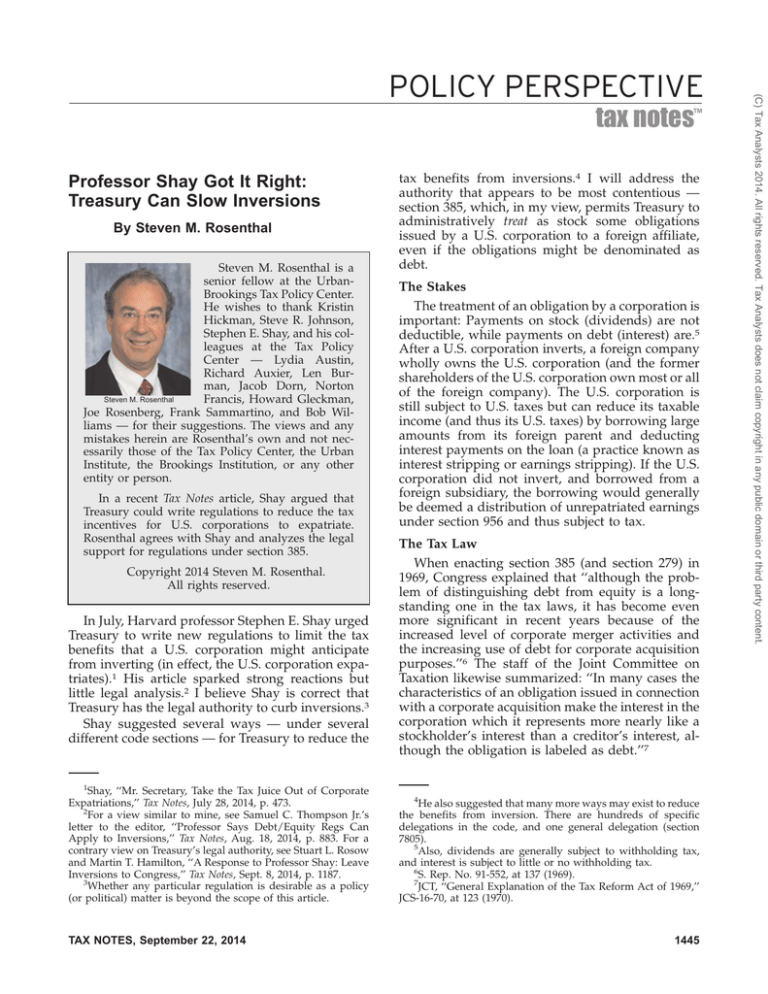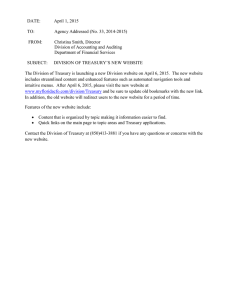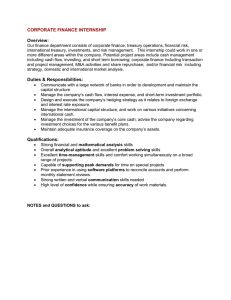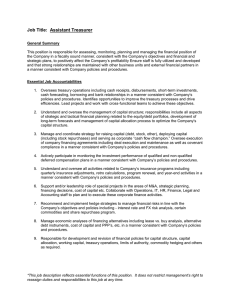
tax notes™
Professor Shay Got It Right:
Treasury Can Slow Inversions
By Steven M. Rosenthal
Steven M. Rosenthal is a
senior fellow at the UrbanBrookings Tax Policy Center.
He wishes to thank Kristin
Hickman, Steve R. Johnson,
Stephen E. Shay, and his colleagues at the Tax Policy
Center — Lydia Austin,
Richard Auxier, Len Burman, Jacob Dorn, Norton
Steven M. Rosenthal
Francis, Howard Gleckman,
Joe Rosenberg, Frank Sammartino, and Bob Williams — for their suggestions. The views and any
mistakes herein are Rosenthal’s own and not necessarily those of the Tax Policy Center, the Urban
Institute, the Brookings Institution, or any other
entity or person.
In a recent Tax Notes article, Shay argued that
Treasury could write regulations to reduce the tax
incentives for U.S. corporations to expatriate.
Rosenthal agrees with Shay and analyzes the legal
support for regulations under section 385.
Copyright 2014 Steven M. Rosenthal.
All rights reserved.
In July, Harvard professor Stephen E. Shay urged
Treasury to write new regulations to limit the tax
benefits that a U.S. corporation might anticipate
from inverting (in effect, the U.S. corporation expatriates).1 His article sparked strong reactions but
little legal analysis.2 I believe Shay is correct that
Treasury has the legal authority to curb inversions.3
Shay suggested several ways — under several
different code sections — for Treasury to reduce the
1
Shay, ‘‘Mr. Secretary, Take the Tax Juice Out of Corporate
Expatriations,’’ Tax Notes, July 28, 2014, p. 473.
2
For a view similar to mine, see Samuel C. Thompson Jr.’s
letter to the editor, ‘‘Professor Says Debt/Equity Regs Can
Apply to Inversions,’’ Tax Notes, Aug. 18, 2014, p. 883. For a
contrary view on Treasury’s legal authority, see Stuart L. Rosow
and Martin T. Hamilton, ‘‘A Response to Professor Shay: Leave
Inversions to Congress,’’ Tax Notes, Sept. 8, 2014, p. 1187.
3
Whether any particular regulation is desirable as a policy
(or political) matter is beyond the scope of this article.
TAX NOTES, September 22, 2014
tax benefits from inversions.4 I will address the
authority that appears to be most contentious —
section 385, which, in my view, permits Treasury to
administratively treat as stock some obligations
issued by a U.S. corporation to a foreign affiliate,
even if the obligations might be denominated as
debt.
The Stakes
The treatment of an obligation by a corporation is
important: Payments on stock (dividends) are not
deductible, while payments on debt (interest) are.5
After a U.S. corporation inverts, a foreign company
wholly owns the U.S. corporation (and the former
shareholders of the U.S. corporation own most or all
of the foreign company). The U.S. corporation is
still subject to U.S. taxes but can reduce its taxable
income (and thus its U.S. taxes) by borrowing large
amounts from its foreign parent and deducting
interest payments on the loan (a practice known as
interest stripping or earnings stripping). If the U.S.
corporation did not invert, and borrowed from a
foreign subsidiary, the borrowing would generally
be deemed a distribution of unrepatriated earnings
under section 956 and thus subject to tax.
The Tax Law
When enacting section 385 (and section 279) in
1969, Congress explained that ‘‘although the problem of distinguishing debt from equity is a longstanding one in the tax laws, it has become even
more significant in recent years because of the
increased level of corporate merger activities and
the increasing use of debt for corporate acquisition
purposes.’’6 The staff of the Joint Committee on
Taxation likewise summarized: ‘‘In many cases the
characteristics of an obligation issued in connection
with a corporate acquisition make the interest in the
corporation which it represents more nearly like a
stockholder’s interest than a creditor’s interest, although the obligation is labeled as debt.’’7
4
He also suggested that many more ways may exist to reduce
the benefits from inversion. There are hundreds of specific
delegations in the code, and one general delegation (section
7805).
5
Also, dividends are generally subject to withholding tax,
and interest is subject to little or no withholding tax.
6
S. Rep. No. 91-552, at 137 (1969).
7
JCT, ‘‘General Explanation of the Tax Reform Act of 1969,’’
JCS-16-70, at 123 (1970).
1445
(C) Tax Analysts 2014. All rights reserved. Tax Analysts does not claim copyright in any public domain or third party content.
POLICY PERSPECTIVE
COMMENTARY / POLICY PERSPECTIVE
Section 385(a). Authority to prescribe regulations. The Secretary is authorized to prescribe
such regulations as may be necessary or appropriate to determine whether an interest in a
corporation is to be treated for purposes of this
title as stock or indebtedness (or as in part
stock and in part indebtedness).
Section 385 is unusual for the code: Its sole
purpose is to provide Treasury with broad authority. Subsection (a), quoted above, authorizes Treasury to write appropriate regulations for all
purposes of the code (including income tax, withholding tax, and other provisions). And subsection
(b) directs Treasury, in these regulations, to set forth
factors ‘‘for a particular factual situation whether a
debtor-creditor relationship exists or a corporateshareholder relationship exists.’’8 Congress suggested five factors for Treasury to consider, but
authorized Treasury to include other factors — or
reject any of Congress’ five factors — for any
particular situation, anticipating the need for different tests in different situations.9
In the same 1969 legislation, Congress added a
law that disallowed interest deductions on some
debt incurred by corporations when acquiring the
stock or assets of another corporation (section 279).
But Congress explained that Treasury ‘‘is not bound
or limited by the [section 279 rules] for distinguishing debt from equity in the corporate acquisition
context’’ in writing regulations under section 385.10
In 1989, Congress expanded Treasury’s authority
under section 385: It permitted Treasury to treat an
instrument having significant debt and equity characteristics as part debt and part equity.11 But that
legislation did not limit any of Treasury’s authority
under section 385.
In the 1989 legislation, Congress also added a
new subsection 163(j), which limited deductions for
8
In 1992 Congress added section 385(c), which requires
issuers and holders to classify an instrument consistently. But
Congress did not add to or limit Treasury’s authority to write
regulations under subsection (a).
9
Congress based its factors on both the characteristics of the
debt instrument and the characteristics of the holder of the
instrument (i.e., whether the holders were also stockholders). In
short, Congress granted Treasury wide latitude: It did not
require Treasury to weigh exclusively, or disproportionately,
any specific factors.
10
S. Rep. No. 91-552, supra note 6, at 138-139; JCT, supra note
7, at 124.
11
The Omnibus Budget Reconciliation Act of 1989; H. Rep.
No. 101-386, at 562 (1989).
interest paid to related parties that are exempt from
U.S. tax on the interest received. The rule disallowed a deduction for ‘‘disqualified interest,’’ but
the disallowed deduction could be carried forward
to future years. Congress apparently added this rule
to address earnings stripping by foreign affiliates of
U.S. corporations.12
But Congress did not — in section 163(j) or its
legislative history — limit Treasury’s authority to
issue guidelines to treat obligations as equity under
section 385. Rather, Congress continued to believe
section 385 could coexist with other approaches to
disallow interest. While enacting section 163(j),
Congress considered whether to treat interest on
parent-guaranteed debt as disqualified. Instead of
extending section 163(j) to guaranteed debt, Congress authorized Treasury to write regulations to
disallow interest on that debt ‘‘where the use of
guaranteed third-party debt is a device for avoiding
the operation of the earning stripping rules.’’13
Congress also explained that its grant of authority
‘‘was not intended to restrict Treasury’s ability
under current law to recharacterize certain guaranteed loans as equity.’’14
The Administrative Law
As a general proposition, the Supreme Court has
stated that in ‘‘an area as complex as the tax system,
the agency Congress vests with administrative responsibility must be able to exercise its authority to
meet changing conditions and new problems.’’15
And agencies often use broad grants of authority to
go beyond the specific problem that prompted
Congress to legislate in the first place.16 Congress
can delegate without a crystal ball.
12
Section 163(j) applies to both tax-exempt organizations and
foreign persons, but tax-exempt organizations were already
slowed by section 512(b)(13).
13
Treasury never wrote these regulations, and Congress, in
1993 legislation, added interest on some guaranteed debt as
disqualified interest under section 163(j).
14
H. Rep. No. 101-386, at 567 (1989). The report cited the
IRS’s ability to challenge guaranteed loans in court as an
example but, in my view, Congress also preserved Treasury’s
authority to recharacterize guaranteed loans as equity under
section 385.
15
Bob Jones University v. United States, 461 U.S. 574, 596 (1983).
16
See, e.g., United States v. Southwest Cable Co., 392 U.S. 157,
172 (1968). (The Court observed that although Congress may not
have foreseen the development of terrestrial delivery, the expansive language of 47 U.S.C. section 152(a) suggests that it
intended to give the Federal Communications Commission
sufficient flexibility to maintain ‘‘a grip on the dynamic aspects
of’’ video programming so the agency could pursue the statute’s
objectives as industry technology evolves.) See also Massachusetts
v. EPA, 549 U.S. 497, 532 (2007) (‘‘While the Congresses that
drafted [section] 202(a)(1) [of the Clean Air Act] might not have
appreciated the possibility that burning fossil fuels could lead to
global warming, they did understand that without regulatory
(Footnote continued on next page.)
1446
TAX NOTES, September 22, 2014
(C) Tax Analysts 2014. All rights reserved. Tax Analysts does not claim copyright in any public domain or third party content.
To deal with these problems and wider situations, Congress expressly authorized Treasury to
write rules for particular factual situations, whether
in connection with an acquisition or not.
COMMENTARY / POLICY PERSPECTIVE
flexibility, changing circumstances and scientific developments
would soon render the . . . Act obsolete. The broad language of
[section] 202(a)(1) reflects an intentional effort to confer the
flexibility necessary to forestall such obsolescence.’’).
17
Chevron USA Inc. v. Natural Resources Defense Council Inc.,
467 U.S. 837, 843-844 (1984).
18
Id. at 848.
19
Mayo Foundation for Medical Education and Research v. United
States, 131 S. Ct. 704, 712 (2011) (the Court expressly rejected a
lesser deference for Treasury regulations).
20
Id. at 707.
21
Id. at 713.
22
Id. at 712 (quoting Smiley v. Citibank (South Dakota) NA, 517
U.S. 735, 740 (1996)).
23
See, e.g., Steve R. Johnson, ‘‘Reasoned Explanation and IRS
Adjudication,’’ 63 Duke L.J. 1771, 1773-1774 (2014); Lawrence
Zelenak, ‘‘Maybe Just a Little Special, After All?’’ 63 Duke L.J.
1897 (2014); and Kristin E. Hickman, ‘‘Unpacking the Force of
Law,’’ 66 Vanderbilt L. Rev. 465, 466 (2013).
TAX NOTES, September 22, 2014
result, tax professionals must realign their intuition;
they must apply administrative law principles to
tax rules.
What Can Treasury Do With Section 385?
Treasury can identify different factors for different situations to treat corporate obligations as stock,
not debt, under section 385.24 Shay suggested that
Treasury write a regulation to classify as equity any
debt issued by an expatriated entity to a foreign
affiliate to the extent that the debt was excessive
based on a test of the expatriated entity’s debtequity ratio and the size of its interest deductions. I
believe Shay’s approach would work, but I suggest
Treasury instead simply identify particular factors
that, if satisfied, would automatically treat a corporate interest as stock. I think this factor approach
aligns better with the delegation in section 385.25
For example, Treasury could treat obligations of a
corporation as equity if (1) the obligations were
issued in connection with an inversion in which its
former shareholders retain a majority ownership of
the corporation (or, if Treasury desired a broader
factor, in connection with any specified corporate
merger and acquisition transaction involving its
shares); (2) the obligations were held by a related
person (including a corporation) that is not subject
to U.S. tax;26 (3) the corporation’s debt-equity ratio
substantially exceeds the average debt-equity ratio
of its affiliated group; and (4) the corporation’s
interest deductions exceed 25 percent of its earnings
before interest, taxes, depreciation, and amortization.27
Of these four factors, the first two relate to the
holder of the instrument, and the second two relate
to the issuer. In the first factor, we test how the
holder came about acquiring the interest. In the
second, we test whether the holder is related to the
24
Admittedly, Treasury’s track record in writing regulations
under section 385 is poor. In March 1981 it proposed regulations
under section 385 and finalized them 11 months later. Less than
two years later, it withdrew the regulations in the face of
widespread criticism of the mechanical tests (which permitted
taxpayers to manipulate the rules). But, as discussed in the
administrative law section above, Treasury’s past efforts are not
a factor in evaluating the legality of any future efforts.
25
By contrast, Treasury’s withdrawn regulations under section 385 provided a series of bright-line tests (and a safe harbor)
to determine whether an instrument was debt or equity, rather
than a multiple factor approach. T.D. 7747.
26
A foreign corporation that is treated as a U.S. corporation
under section 7874(b) would be subject to U.S. tax and, thus, not
described in this factor.
27
Treasury also might issue further guidance to define ‘‘inversion,’’ ‘‘merger,’’ ‘‘related,’’ ‘‘substantially,’’ ‘‘large share,’’
and other key terms in the regulations. Treasury’s interpretation
of an ambiguity in its regulations would be accepted, unless the
interpretation was ‘‘plainly erroneous.’’ Bowles v. Seminole Rock
& Sand Co., 324 U.S. 410, 413-414 (1945).
1447
(C) Tax Analysts 2014. All rights reserved. Tax Analysts does not claim copyright in any public domain or third party content.
In 1984, in Chevron, the Supreme Court established the framework to evaluate the exercise of
delegated authority: ‘‘If Congress has explicitly left
a gap for the agency to fill, there is an express
delegation of authority to the agency to elucidate a
specific provision of the statute by regulation. Such
legislative regulations are given controlling weight
unless they are arbitrary, capricious, or manifestly
contrary to the statute.’’17 For the treatment of an
interest in a corporation as stock or debt, Congress
explicitly gave Treasury such a gap to fill. The Court
further stated, ‘‘When a challenge to an agency
construction of a statutory provision . . . really centers on the wisdom of the agency’s policy, rather
than whether it is a reasonable choice within a gap
left open by Congress, the challenge must fail.’’18
Thus, the Court affirmed that disagreeing with the
agency’s policy decision is not grounds for objecting to its action.
In 2011, in Mayo, the Supreme Court unanimously held that tax regulations, like other regulations, are entitled to Chevron deference.19 As the
Court explained, ‘‘Filling gaps in the Internal Revenue Code plainly requires the Treasury Department to make interpretive choices for statutory
implementation at least as complex as the ones
other agencies must make in administering their
statutes.’’20
In Mayo, the Court also held that ‘‘the principles
underlying our decision in Chevron apply with full
force in the tax context.’’21 Under those principles,
Treasury may change its regulatory approach and
the new approach will still benefit from Chevron
deference. The Court also noted that ‘‘neither antiquity nor contemporaneity with a statute is a condition of a regulation’s validity.’’22
Mayo effectively laid to rest the notion of ‘‘tax
exceptionalism,’’ the idea that tax rules should be
subject to a different administrative review.23 As a
COMMENTARY / POLICY PERSPECTIVE
Congress expressly authorized Treasury to write
‘‘appropriate’’ regulations to treat an interest in a
corporation as stock or debt in particular factual
situations. The courts will uphold Treasury’s regulations unless they are (1) procedurally defective,
(2) arbitrary or capricious, or (3) manifestly contrary
to the statute. Let’s take those limitations in order.29
First, on procedure, Treasury must satisfy the
Administrative Procedure Act’s notice and comment process. It might apply the new rules only to
obligations issued after the date the new regulations are announced — or to any interest accrued
after that date if the relevant corporate M&A transaction occurred after a specified date. (Indeed,
Treasury could apply the new rules to obligations
issued after 1969, although as a policy matter,
retroactive effective dates are disfavored.30)
Second, Treasury must write regulations that are
not arbitrary or capricious, which requires reasonableness.31 A regulation would violate that rule if
Treasury ‘‘relied on factors which Congress has not
intended it to consider, entirely failed to consider an
important aspect of the problem, offered an explanation for its decision that runs counter to the
evidence before the agency, or is so implausible that
it could not be ascribed to a difference in view or the
product of agency expertise.’’32
28
I think this factor would pass a treaty challenge, since it
applies to both domestic and foreign persons that are exempt
from U.S. tax.
29
Chevron often is framed as a two-step test, and step one
asks whether an agency’s construction is invalid because the
construction is contrary to a clear statute. In section 385,
Congress explicitly authorized Treasury to write rules to treat an
interest in a corporation as stock or debt — not a rule that
defines stock or debt. If Treasury writes such a rule, it will
hardly be contrary to a clear statute. That leaves Chevron step
two (whether the agency’s construction is permissible), which I
analyze in the text above.
30
Section 385 permits Treasury to write regulations for debt
instruments issued after 1969. In 1996 Congress enacted section
7805(b), which limits retroactive regulations except in the case of
abuse. But section 7805(b) was effective for ‘‘regulations which
relate to statutory provisions enacted on or after the date of the
enactment of’’ the Taxpayer Bill of Rights II. So I believe the
section 7805(b) limitation is inoperative here. For a contrary
view of the effective date of section 7805(b), see John Bunge,
‘‘Statutory Protection From IRS Reinterpretation of Old Tax
Laws,’’ Tax Notes, Sept. 8, 2014, p. 1177.
31
Johnson, ‘‘Preserving Fairness in Tax Administration in the
Mayo Era,’’ 32 Va. T. Rev. 269 (2012).
32
Motor Vehicle Manufacturers Association v. State Farm Mutual
Automobile Insurance Co., 463 U.S. 29 (1983). See Patrick J. Smith,
Congress delegated broad authority to Treasury
to treat an interest in a corporation as stock or debt.
It also gave Treasury wide latitude to identify
factors to determine whether a corporationshareholder relationship or a debtor-creditor relationship exists for a particular factual situtation. It
did not rule out any factors to consider — and it
expressly authorized Treasury to add factors, as
appropriate. My four factors, in combination, address a circumstance in which equity may, from a
policy perspective, be improperly substituted for
debt and, at a minimum, create an opportunity for
abuse.
Some may object that the first factor (how the
holder came about acquiring the interest) singles
out U.S. corporations that invert (or, alternatively,
engage in other specified M&A transactions). And
perhaps that factor might better be characterized as
a particular factual situation, and the other three
factors applied to it. But, whether as a factor or a
particular factual situation, this history warrants
special consideration. That is because equity is often
replaced with debt (and deductible interest payments) in an inversion or other corporate M&A
transaction, as Congress observed in 1969.33
Moreover, several years ago Treasury studied the
capital structure of U.S. corporations that invert. It
concluded that ‘‘there is strong evidence of earnings
stripping by the subset of foreign-controlled domestic corporations consisting of inverted corporations
(i.e., former U.S.-based multinationals that have
undergone inversion transactions).’’34 Admittedly,
in the report, Treasury cautioned, ‘‘It is not possible
to quantify with precision the extent of earnings
stripping by foreign-controlled domestic corporations generally.’’ The study supports Treasury’s
focus on inverted companies. But as part of the
notice and comment process, Treasury should solicit public input on the extent of the earnings
stripping of U.S. corporations that are inverted, of
those that otherwise engage in M&A activity, and of
all other corporations with borrowings from taxexempt affiliates.
‘‘The APA’s Arbitrary and Capricious Standard and IRS Regulations,’’ Tax Notes, July 16, 2012, p. 271.
33
Treasury also is mindful of today’s circumstances: There
are a large number of U.S. corporations ready to invert. And
once a corporation inverts, it’s gone from the U.S. tax base. So,
Treasury might justifiably address the challenge at hand — and
later write broader rules for borrowing by U.S. corporations
from foreign affiliates.
34
Treasury, ‘‘Report to the Congress on Earnings Stripping,
Transfer Pricing and U.S. Income Tax Treaties,’’ at 3 (Nov. 2007).
(Footnote continued in next column.)
1448
TAX NOTES, September 22, 2014
(C) Tax Analysts 2014. All rights reserved. Tax Analysts does not claim copyright in any public domain or third party content.
issuer (which is similar to the relationship factor
suggested already in the statute).28 In the third and
fourth, we test the financial condition of the issuer
(which is suggested by one of the factors in the
statute already, the debt-equity factor).
COMMENTARY / POLICY PERSPECTIVE
35
Indeed, if the lender is the sole shareholder, key attributes
of debt are irrelevant, like creditors’ rights. As David C. Garlock
and Amin N. Khalaf observed, it is ‘‘difficult to see why
creditors’ rights are of great importance, or in fact of any
importance whatsoever. A parent corporation obviously is not
going to sue its wholly owned subsidiary to collect on an
intercompany debt and would not force the subsidiary into a
bankruptcy proceeding.’’ Garlock and Khalaf, ‘‘Debt vs. Equity:
Myths, Best Practices and Practical Considerations for U.S. Tax
Aspects of Related-Party Financings,’’ 92 Taxes 37, 45 (2014).
36
See, e.g., Verizon Communications v. FCC, 535 U.S. 467, 542
(2002).
Finally, the new regulations would not be manifestly contrary to section 385. Congress tackled the
problem of debt arising in corporate mergers with
two rules, one that could apply in either corporate
merger situations or other situations — or both
(section 385) — and one that could apply only to
corporate acquisitions (section 279). There is no
indication that Congress limited Treasury’s authority then or later.37
Ultimately, in my view, Treasury can reasonably
write regulations under section 385 that apply to a
narrow range of obligations, with a broad set of tax
consequences (that is, for both income and withholding tax purposes). By contrast, other provisions
(like section 163(j) or section 279) might apply to a
broader range of obligations, but with narrower
effect (for example, interest deferral, not permanent
disallowance). These various approaches are easily
reconciled.
Conclusion
Treasury can use its authority under section 385
to treat some obligations of inverted corporations as
stock, not debt. And Congress expected Treasury to
treat some corporate obligations as stock without
regard to Congress’s other efforts to limit interest
deductions on those obligations. New Treasury
regulations would not prevent inversions, but they
would reduce the tax benefits of those deals. But
ultimately, Treasury must decide, as a policy and
political matter, how to proceed.
37
A later statute will not be held to have implicitly repealed
an earlier one unless there is a ‘‘clear repugnancy’’ between the
two. Georgia v. Pennsylvania Railroad Co., 324 U.S. 439, 456-457
(1945).
SUBMISSIONS TO TAX NOTES
Tax Notes welcomes submissions of commentary and
analysis pieces on federal tax matters that may be of
interest to the nation’s tax policymakers, academics,
and practitioners. To be considered for publication,
TAX NOTES, September 22, 2014
articles should be sent to the editor’s attention at
taxnotes@tax.org. Submission guidelines and FAQs are
available at taxanalysts.com/submissions.
1449
(C) Tax Analysts 2014. All rights reserved. Tax Analysts does not claim copyright in any public domain or third party content.
Some also may object that the second factor
focuses on attributes of the lender (that is, relatedness) as opposed to attributes of the debt instrument. But one of the factors already suggested in
section 385(b) focuses on the nature of the lender
(that is, whether the holder of the debt is also a
stockholder). That relationship is important to distinguish debt from stock as a matter of tax policy:
When stock and debt are always held in equal
proportion across owners, there is little meaningful
difference in the rights of the two types of holdings
(and a strong incentive for the stockholders to shift
more of their economic interest to debt). This is
more obvious for a corporation that is wholly
owned by its lender (which occurs in an inversion).35
Most importantly, the arbitrary and capricious
standard is relatively easy for an agency to satisfy.
The agency must only show that its policy decision
is ‘‘rationally related’’ to the statute’s policy goals
and that the decision comports with the structure of
the statute.36 That is because Congress delegates
legislative authority to allow Treasury to fill in gaps.
And a court will test Treasury only on whether its
choice is reasonable, not on whether its choice is,
from the court’s perspective, the best alternative on
policy or legal grounds.





